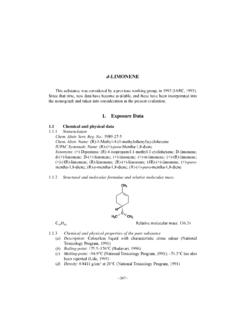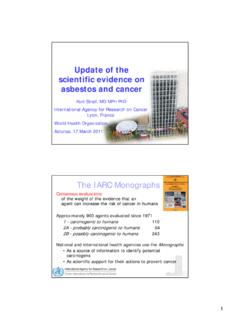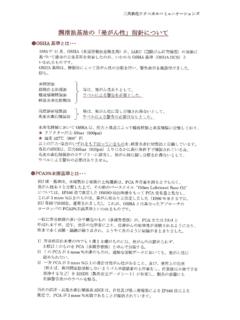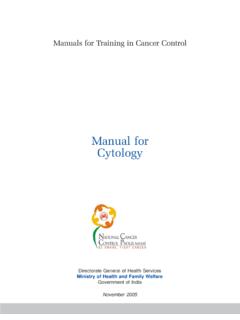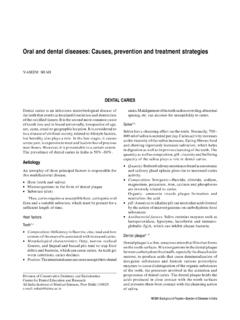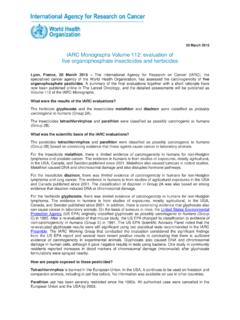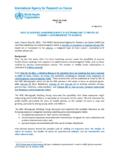Transcription of 1 Exposure Data - monographs.iarc.fr
1 4011 Exposure Identification of the agentFrom ( iarc , 2006).Chem. Abstr. Serv. Reg. No.: 50-00-0 Chem. Abstr. Name: FormaldehydeIUPAC Systematic Name: MethanalSynonyms: Formaldehyde gas; formic aldehyde; methaldehyde; methyl alde-hyde; methylene oxide; oxomethane; oxymethyleneCOHHCH2 ORelative molecular mass: : Colourless gas with a pungent odourConversion factor: mg/m3 = ppm; calculated from: mg/m3 = (relative molecular ) ppm, assuming standard temperature (25 C) and pressure (103. 5 k Pa).1. 2 UseFormaldehyde is produced worldwide on a large scale by catalytic, vapour-phase oxidation of methanol. Formaldehyde is used mainly in the production of various types of resin. Phenolic, urea, and melamine resins have wide uses as adhesives and binders in the wood-production, pulp-and-paper, and the synthetic vitreous-fibre industries, in the production of plastics and coatings, and in textile finishing. Polyacetal resins are widely used in the production of plas-tics.
2 Formaldehyde is also used extensively as an intermediate in the manufacture of industrial chemicals, such as 1,4-butanediol, 4,4 -methyl-enediphenyl diisocyanate, penta-erythritol, and hexamethylenetetramine. Formaldehyde is used directly in aqueous solution (known as formalin) as a disinfectant and preservative in many appli-cations ( iarc , 2006).FORMALDEHYDEF ormaldehyde was considered by previous iarc Working Groups in 1981, 1987, 1994, and 2004 (IAR C , 19 82, 19 87, 19 95, 2006). Since that time new data have become available, which have been incorporated in this Monograph, and taken into consideration in the present MONOGRAPHS Occurrence and Environmental occurrence and exposureFormaldehyde is found as a natural product in most living systems and in the environment. It occurs naturally in fruits and some foods, and it is formed endogenously in mammals, including humans, as a consequence of oxida-tive metabolism.
3 In addition to these natural sources, common non-occupational sources of Exposure to formaldehyde include combus-tion processes, through emissions from motor vehicles, power plants, incinerators, refineries, wood stoves, and kerosene heaters. Formaldehyde may be released from particle boards and similar building materials, carpets, paints and varnishes, during cooking of some foods, and during its use as a disinfectant. It is also present in tobacco smoke. An indirect source of Exposure to formaldehyde is its formation via photochemical oxidation of hydrocarbons, such as methane, and other precursors emitted from combustion processes (N T P, 2 0 0 5; iarc , 2006). Formaldehyde has a short half-life in the envi-ronment, because it is removed from the air by photochemical processes and by precipitation and biodegradation (N T P, 2 0 0 5).Concentrations of formaldehyde in outdoor air are generally below mg/m3 in remote areas and below mg/m3 in urban settings.
4 The levels of formaldehyde in indoor air of houses are typically mg/m3; indoor combustion sources can significantly increase these levels. Cigarettes may contribute as much as 10 25% of the indoor Exposure . Average concentrations of mg/m3 or more have been measured in mobile homes , but these have declined since the late 1980s as a result of stand-ards that require that building materials particle boards emit lower concentrations of formaldehyde. A recent study of emissions from mosquito coils found the average concentration of formaldehyde exceeded 100 g/m3 ( iarc , 2006, 2010; Lee & Wang, 2006). Data on formaldehyde concentrations in outdoor air in residential and public settings, and information on Exposure to formaldehyde associated with household use of solid fuels and high-temperature frying, have been reviewed in iarc Monograph Vo l u m e s 8 8 and 95 ( iarc , 2006, 2010).
5 Automobile exhaust is a major source of formaldehyde in ambient air. Recent reports suggest that formaldehyde emissions may be higher from vehicles powered by compressed natural gas compared with those running on ethanol or gasohol (Corr a & Arbilla, 2005), and that these emissions may be decreased by substi-tution of an ethanol-biodiesel-diesel blend for diesel fuel (Shi et al., 2006). In addition, formal-dehyde can be absorbed through the skin from cosmetics or via contact with other consumer products containing formaldehyde, such as unwashed permanent-press fabrics treated with formaldehyde-releasing resins (N T P, 2 0 0 5). Occupational exposureOccupational Exposure to formaldehyde occurs in a wide variety of occupations and industries. CAREX (CARcinogen Exposure ) is an international information system on occupational Exposure to known and suspected carcinogens based on data collected in the European Union (EU) from 1990 to 1993.
6 The CAREX database provides selected Exposure data and documented estimates of the number of exposed workers by country, carcinogen, and industry (Kauppinen et al., 2000). Ta ble presents the results for formaldehyde in the EU by industry (CAREX, 1999).In iarc Monograph Volume 88 ( iarc , 2006) data were reviewed on occupational Exposure to formaldehyde by type of industry. The highest continuous exposures (2 5 ppm; mg/m3) were measured in the past during varnishing of furniture and wooden floors, in the finishing of 402 Formaldehyde403 Table Estimated numbers of workers exposed to formaldehyde above background levels in the European UnionIndustry, occupational activityManufacture of furniture and fixtures, except primarily of metal179000 Medical, dental, and other health and veterinary services174000 Manufacture of wearing apparel, except footwear 94000 Manufacture of wood and wood and cork products, except furniture 70000 Personal and household services 62000 Construction 60000 Manufacture of textiles 37000 Iron and steel basic industries 29000 Manufacture of fabricated metal products, except machinery 29000 Manufacture of other non-metallic mineral products 23000 Manufacture of machinery.
7 Except electrical 20000 Manufacture of industrial chemicals 17000 Manufacture of other chemical products 17000 Manufacture of plastic products not classified elsewhere 16000 Agriculture and hunting 16000 Manufacture of paper and paper products 13000 Printing, publishing and allied industries 13000 Wholesale and retail trade and restaurants and hotels 13000 Manufacture of transport equipment 11000 Manufacture of electrical machinery, apparatus and appliances 10000 Manufacture of footwear 9000 Manufacture of glass and glass products 8000 Research and scientific institutes 7000 Non-ferrous metal basic industries 6000 Manufacture of leather and products of leather or of its substitutes 6000 Beverage industries 4000 Manufacture of instruments, photographic and optical 4000 Other manufacturing industries 3000 Food manufacturing 3000 Crude petroleum and natural gas production 2000 Manufacture of rubber products 4000 Financing, insurance, real estate and business services 3000 Education services 2000 Sanitary and similar services 2000 Services allied to transport 2000 Manufacture of miscellaneous products of petroleum and coal 1000 Other industries 2000 Total (all industries)971000 From Kauppinen et al.
8 (2000), CAREX (1999) iarc MONOGRAPHS 100 Ftextiles, in the garment industry, in the treatment of fur, and in certain jobs within manufactured board mills and foundries. Short-term exposures to high levels (3 ppm and higher; mg/m3) have been reported for embalmers, pathologists, and paper workers. Lower concentrations have usually been encountered during the manufac-ture of man-made vitreous fibres, abrasives and rubber, and in formaldehyde-production indus-tries. A very wide range of Exposure levels has been observed in the production of resins and plastic products. The development of resins that release less formaldehyde, and improved venti-lation have resulted in lower Exposure levels in many industrial settings in recent decades ( iarc , 2006).2. Cancer in Cancer of the nasopharynxIn iarc Monograph Volume 88 ( iarc , 2006) it was concluded that there was sufficient evidence for the carcinogenicity of formaldehyde, based primarily on its association with nasopharyn-geal cancer.
9 There have been relatively few new studies published on this association since that time, although there have been several re-evalu-ations and . Co h o r t s t u d i e sIn the most recent follow-up of the largest cohort study from the USA of industrial workers exposed to formaldehyde, a statistically signifi-cant excess of deaths from nasopharyngeal cancer was observed in comparison with the US national population, with statistically significant Exposure response relationships for peak expo-sure and cumulative Exposure (Hauptmann et al., 2004; see Table available at ble2 . d f). Based on eight cases, a significant excess mortality from nasopharyngeal cancer was observed among formaldehyde-exposed workers (SMR, ; 95%CI: ). A highly statistically significant (Ptrend < ) Exposure response relationship was observed between peak- Exposure to formaldehyde and risk for nasopharyngeal cancer in a Poisson regression-analysis.
10 All exposed cases were in the highest category of peak- Exposure , and the relative risk was This analysis excluded one case which, according to cancer registry data, had been misclassified as nasopharyngeal cancer. Weaker Exposure response relationships were observed between nasopharyngeal cancer and average or cumulative Exposure , and duration of Exposure (Ptrend = , and , respectively).In the two other large cohort studies of indus-trial workers, cases of nasopharyngeal cancer were fewer than expected, but the power of these studies to detect an effect on nasopharyngeal cancer was low and the deficits were small. In the first study, of British chemical workers, one death was observed when were expected (Coggon et al., 2003); in the second study, no deaths were observed among US garment-manufacturers, where were expected (Pinkerton et al., 2004).An excess of deaths from nasopharyngeal cancer was observed in a proportionate mortality analysis of the largest US cohort of embalmers (Hayes et al.)


